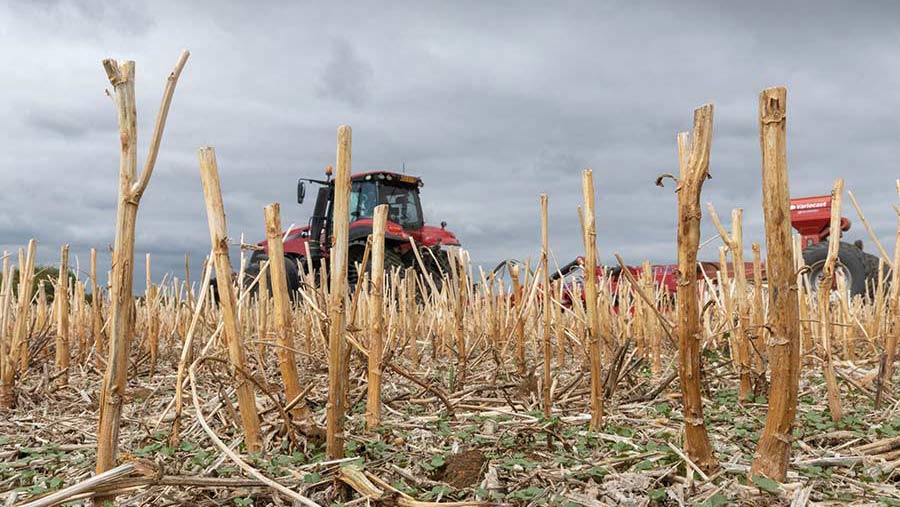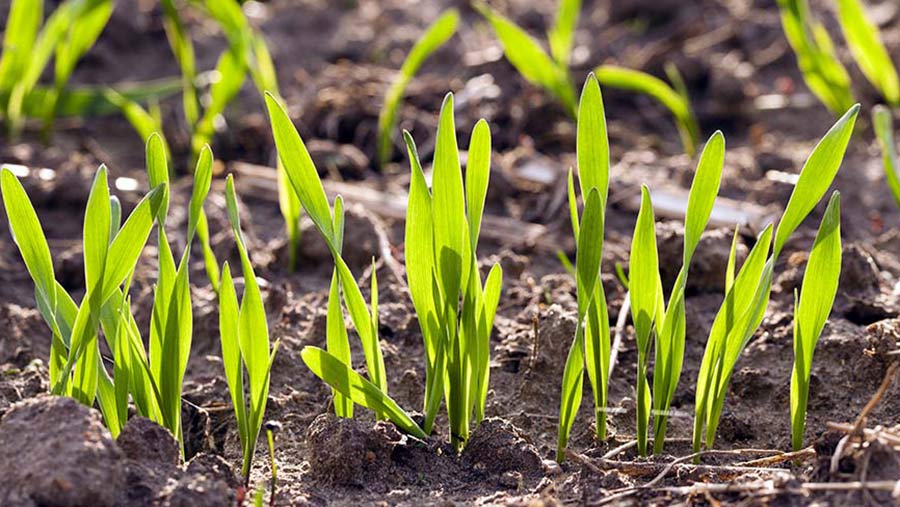Regenerative agriculture: Tips on building carbon-rich soils
 © Tim Scrivener
© Tim Scrivener Carbon-rich soils that are high in organic matter bring many advantages, from higher yields, lower inputs and reduced costs to more resilience to climate instability – as well as more carbon captured and stored.
Getting it right with soils has multiple benefits, says FarmED head of sustainability Jonty Brunyee, who adds there are knock-on effects when trapping and storing carbon in the soil and above-ground biomass.
See also: Regenerative agriculture: What to avoid and how to start
“Where you have a biologically active soil that is full of life, you get healthier crops with functioning roots that require fewer interventions. Crucially, soil exudate pathways are working, so carbon is being stored at depth.”
For farmers, there are three main ways of building soil carbon:
- Root exudates
- Restrict soil movement to prevent oxidisation
- Increase deposits through residue management
While all of these play a role, root exudates are the mainstay, as most carbon building happens through photosynthesis and root exudates (see “How biological pathways produce carbon-rich soils”), with plant roots building soil carbon between five and 30 times faster than carbon from above-ground biomass.
For growers who aren’t familiar with measuring carbon, soil organic matter is approximately 60% carbon – some of which is strongly bound and very stable.
That matters if you’re trying to sequester it, explains Rothamsted Research soil scientist David Powlson, who adds that the remainder is free and unstable, which is important for microbial activity.
“It has a role in soil health and soil function, which is why it helps with providing food security and ecosystem services,” he says. “For this purpose, it’s the flow of carbon through the soil that matters.
“Its other role is in the global carbon cycle and the effect that has on climate change. If more carbon is put into soils, it slows climate change. For that, it’s the quantity of carbon that matters.”
Prof Powlson adds that a little bit of soil organic carbon can go a long way and have a big effect on soil properties and biology.
“While that may not guarantee higher yields, especially in winter-sown crops, it does improve the soil’s physical properties, making it more resilient and easier to work.
“Increasing soil organic matter is always good for soil functioning. It also helps with nutrient supply, which is why savings in fertiliser costs are possible.”
How biological pathways produce carbon-rich soils
If you want good soil, you need to have plants, says Christine Jones, an Australian expert on soil biology. She stresses that weathered rock only turns into topsoil after it has been in contact with plant roots.
She explains that it happens through photosynthesis: when green plants capture sunlight and carbon dioxide, they produce sugars and carbon compounds. Some of these are exuded from their roots into the soil profile.
These exudates then feed the soil microbes, in an active, mutually beneficial process that sees soil particles sticking to plant roots. The huge amount of microbial activity inside the rhizosheath – which is the name given to the soil that adheres to the roots – causes soil aggregates to form.
“These rhizosheaths are hotspots,” says Dr Jones. “There are huge numbers of microbes in them, which are fed by the sugars coming from the roots.

© Adobe Stock
“The two main things that happen are that energy is distributed from the roots to the soil microbiome, and the fungal hyphae then produce sticky substances that start to pull soil aggregates together,” she explains.
“Microbes are responsible for the process, but functioning roots are required.”
In this way, plants change soil structure, often taking it from being compacted and difficult to work to friable. Plants and microbes work together to produce water-stable aggregates, something Dr Jones refers to as “engineering masterpieces”.
“These aggregates have spaces in them for air and water. They can both hold moisture within them and improve drainage. They are a fundamental unit of soil function.
“The functions that take place are extraordinary. It can be described as a form of co-ordinated messaging between microbes and plants.”
Case study: Andrew Jackson, Lincolnshire
Soil organic matter levels have been rising since 2016 on a 375ha Lincolnshire farm, when Andrew Jackson took the decision to change the way he farms.
Having researched regenerative agriculture and come across Base-UK, where he met like-minded farmers willing to share their experiences, he took the plunge and joined their ranks, intent on farming sustainably.
Farm facts: S Jackson & Sons, Scunthorpe, Lincolnshire

Andrew Jackson © Anna Rachel Photography
- 375ha
- Pink Pig Farm visitor attraction
- Solar panels
- High ropes course
- Wedding venue
Worm numbers
With far less soil disturbance, a wider rotation, greater diversity and the gradual introduction of livestock, he now has some fields that have reached 6% soil organic matter, and he is finding an abundance of worms.
Carrots are no longer being grown on an area of light, sandy land, which is now rented out for outdoor pig production, rotated every two years.
“That means those soils aren’t being knocked out of shape anymore and the pigs and the grass they graze on are providing fertility for the following wheat crop,” explains Mr Jackson.
Quinoa and two-year grass seed crops have recently been included in the rotation, with the latter helping to build organic matter. Niche crop meadowfoam is being introduced this season.
The rotational changes mean oilseed rape is now being grown on a one-in-eight basis, with four different clover species as companions to help with rooting and nutrient cycling.
Mr Jackson’s Horizon drill has multiple hoppers, making it easier where companion crops are being drilled. This also allows him to apply biological products from a rear-mounted tank.
Tight timings
His original plan to grow more cover crops hasn’t come to fruition yet, as many of the crops are autumn sown and timings are considered too tight for successful catch crops.
Cover crops are grown before the quinoa, and he is always searching for rotational refinements to help with soil structure and nutrient capture.
Crop residues have been chopped and returned to the soil for years, and Mr Jackson is now moving on to making his own compost.
“The idea behind it is that it will keep carbon in the loop and put it back into the soil,” he says. “We are trying out the Walter Witte/Bokashi principle and producing an anaerobic compost, so it will be interesting to see how that goes.”
He has also built four Johnson-Su bioreactors for composting and hopes to move on to making compost teas to support the soil’s microbial life.
As he is aware that any surplus nitrogen fertiliser not taken up by the crop will start to erode hard-won gains in soil organic matter, the nitrogen application has been reduced from 220kg/ha to 160kg/ha on wheat. Other crops also received reduced rates.
Fuel savings
In addition, fuel use has halved, thanks to one-pass establishment techniques, and the machinery repair bill is down by one-third.
Yields are holding up well, with wheats averaging 8.5-9t/ha this year.
Mr Jackson accepts that some see him as a “wacky farmer”, but he is really pleased with the direction of travel to date and believes the farm is in a good place for the introduction of the Sustainable Farming Incentive and the Environmental Land Management schemes.
“I’m learning as I go along,” he says. “Getting our soils into shape was the right place to start, and we are now seeing the benefits of that.”
Regenerative agriculture – making the change
This is a five-part series on how to introduce regenerative agriculture. Future articles will look at how to design a diverse rotation, reducing your reliance on artificial inputs and introducing livestock to the system.
Previous article: Regenerative agriculture: What to avoid and how to start

